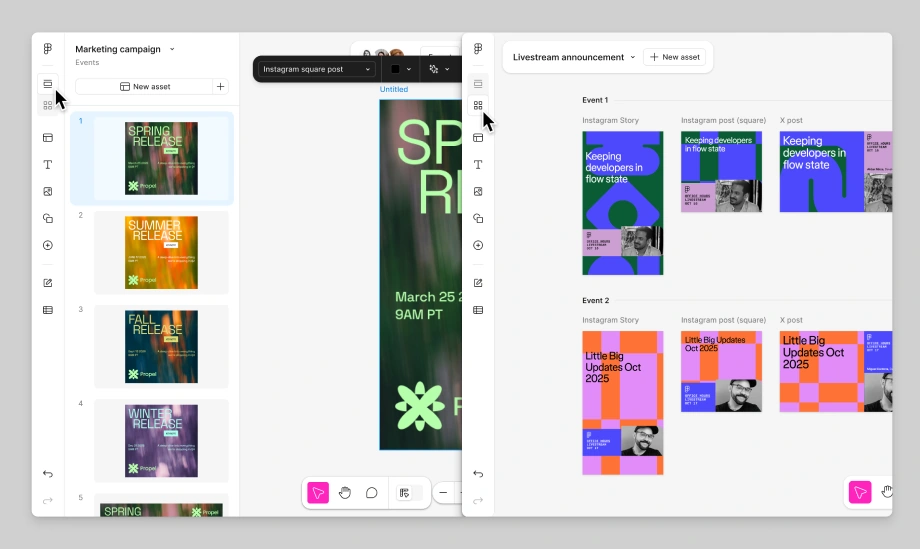Designing the Future Together: Our Take on Config 2025
Config 2025 brought the heat. Figma’s annual global design conference is more than just a product showcase — it’s a high-energy gathering of designers, developers and product teams from around the world. Packed with keynotes, hands-on workshops and major announcements, Config is where the future of collaborative design takes shape. Whether you were glued to the livestream, doom-scrolling Reddit hot takes or live-Slacking every surprise announcement (guilty on all counts), it was clear: Figma is pushing boundaries — sometimes boldly, sometimes shakily — but always with the intent to empower creative collaboration. This was our second year attending the conference, and once again, it brought fresh tools, practical insights and bold visions that promise to reshape how we work.
Caitlynn and Carter from our design and development teams dive into what stood out — and what still needs some love.

Figma Grid: A New Layout Era Begins
Grids in Figma? Yes, finally. This long-anticipated feature lets designers define rigid layouts in a more development-friendly way, separate from auto layout.
Carter’s Take:
“I legit can’t think of a downside. It’s just another great option for designers who need more control.”
Caitlynn’s Take:
“This could be a game-changer for responsive layouts and design/dev handoff. Especially when we’re talking breakpoints and component-level flexibility.”
But here’s the rub:
The community is split. While designers love the idea of Grids, early users hit limitations fast:
- Manual span dragging
- No global span settings
- No fractional or relative units
- Everything needs to be adjusted individually
- Track sizing and grid counts can’t be variable-bound
In short, it’s a promising beta — but it’s not yet the flexible, dev-aligned tool many hoped for. Until then, traditional layout hacks will probably live on.

Figma Sites: Powerful…with asterisks
One of the flashiest reveals was Figma Sites, a CMS-style tool that allows teams to build, launch and share websites directly from Figma. Sounds revolutionary. But this tool is still finding its footing.
Carter’s Take:
“It’s super easy to build and publish and you can use embeds, custom breakpoints, even analytics tracking. But the code it generates? Yikes.”
Caitlynn’s Take:
“As a prototyping tool, it’s incredibly intuitive. It could reshape how we communicate design intent with partners, especially during review phases.”
Community Concerns:
- All elements default to <div> tags, causing massive accessibility and SEO issues
- No custom fonts, forms or 404 pages (yet)
- Screen reader issues and poor semantic structure
- No naked domain support (but it’s coming!)
Even Sho Kuwamoto, VP of Product, acknowledged these problems and says accessibility is being fast-tracked. Still, devs are wary. If Figma Sites wants to replace traditional front-end workflows, it has a long road ahead.

Figma Make: Vibe Coding, Prototyping Reinvented
The coolest-sounding name goes to Figma Make, a new prototyping solution that uses natural language prompts (a.k.a. “vibe coding”) to help build interactive mockups faster.
Caitlynn’s Take:
“This could be a breakthrough in building dynamic prototypes without spending hours in timelines. Imagine prototyping interactions across a full design system in minutes.”
It’s still early, and we haven’t gotten our hands fully on this one yet, but the buzz is real — and so is the potential for speeding up internal and partner-facing design cycles.

Figma Buzz: Rapid Asset Creation Gets Smarter
Figma Buzz isn’t just another plugin — it’s a production tool. It lets teams use templates and spreadsheet data to quickly generate assets, perfect for digital and social campaigns.
Caitlynn’s Highlights:
- Import data from sheets for mass content generation
- Use templates from your design library
- Non-designers (thanks to the new Content Seat) can now create assets without touching layout details
- Major time-saver for marketing and creative ops
Limitations? No video or HTML5 support (yet), and there’s a bit of a learning curve. But once it’s dialed in, Buzz could be huge for campaign efficiency.
Final Thoughts:
Config 2025 was honest. These new tools aren’t perfect, and Figma knows it. But the platform’s commitment to experimentation and improvement makes this an exciting time to be a designer. For our team at DR, it validated that we’re designing in the right ecosystem — one that listens, learns and keeps moving forward.
Some tools (like Grid and Sites) still need refinement. Others (like Make and Buzz) hint at a faster, smarter creative future. Either way, we’re leaving Config with new ideas, a few UI critiques and a lot of inspiration.
Here’s to pushing pixels — and boundaries.

Caitlynn Jones
Digital Designer




